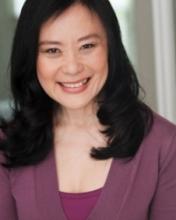Kathy Hsieh is the Cultural Partnerships & Grants Manager for the Seattle Office of Arts & Culture and Co-Executive Producer for SIS Productions. From 1990–1997 she served as Managing Director for the Northwest Asian American Theatre (NWAAT), which was recently featured in the Lost & Founded reading series.
We asked Kathy a few questions about NWAAT and her current work as an artist and arts administrator—work that is driven by a desire to inspire the community will of Seattle’s arts & cultural sector to play a leading role in creating racial equity.
What challenges did the Northwest Asian American Theatre (NWAAT) encounter?
When NWAAT (as Theatrical Ensemble of Asians – TEA) was started by UW students like Marilyn Tokuda, Stan Asis, and Maria Batayola, it enjoyed success because it was the first time locally that the experience of Asian Americans were given a voice on stage and it provided a creative outlet for Asian American students who were not given any other opportunity to perform. With an influx of local and federal funding for a space, an executive director, and teaching artists in the mid-70’s, the organization branched out under the umbrella name of Asian Multimedia, offering a variety of classes for the local Asian American community. At that time, the theatre arm renamed themselves the Asian Exclusion Act. When funding disappeared in the late-70’s, Asian Multimedia disbanded. They had lost their space and paid staff, but Bea Kiyohara (who had appeared in production with the company) kept the theatre arm going under the new name of the Northwest Asian American Theatre (NWAAT). Shortly thereafter they were able to leverage funding to bring on a full-time Managing Director (me) which allowed the company to finally offer a consistent season of shows.
It was the first time locally that the experience of Asian Americans were given a voice on stage and it provided a creative outlet for Asian American students who were not given any other opportunity to perform.
Due to the new direction of the theatre, each of us being presented with other artistic opportunities, and knowing that the company was on solid financial ground, the lead staff (Artistic Director Judi Nihei, Associate Artistic Director Manuel Cawaling, and myself as Managing Director) all chose to move on in late 1997. Unfortunately, after that, there was a quick succession of three different artistic directors over the next few years that led to inconsistent programming and community development. When the Ford Foundation funding ended, along with the recession that hit Seattle in 2001, the theatre struggled to match its increased overhead, and NWAAT never quite recovered.
What was your most memorable show?
I would have to say that being a part of the creation of, producing all of, acting in most of, directing one of, and writing 14 of the episodes of the Sex in Seattle theatre series is probably the most impactful for me in my career (so far). An idea that came out of a conversation between friends and ended up becoming a hugely popular, incredibly successful, and I think still might hold the record for being the longest-running original live theatre serial with the most episodes in the country still blows my mind sometimes. We centered the show around four Asian American women and women have always been the leads not only onstage but off-stage. It led to us starting SIS Productions as a result.
My vision is to inspire the community will of the arts & cultural sector to play a leading role in eliminating structural racism in Seattle.
How did you become interested and dedicated to race and social justice?
As a person of color, many people and situations in this country force us to confront and deal with race whether we want to or not. We can choose to either run away from it or deal with it. But even if we choose to run from it, we can’t ever really escape it as a person of color. That’s the reality of America as it is right now and has been for over 350 years. So I choose to face it and not only that but have dedicated myself in trying to figure out how we can dismantle racism. I like to tell people that my vision is to inspire the community will of the arts & cultural sector to play a leading role in eliminating structural racism in Seattle. (I’m not naïve enough to take on the entire world yet, so will just focus on where I have more agency).
In addition to her work at the Seattle Office of Arts & Culture, Kathy can be seen on stages around town. Catch Kathy in the following shows:
Seattle Public Theater's Amadeus , encore presentation of Paper Angels for SIS Productions at the Seattle Fringe Festival, doing a reading of The World of Extreme Happiness with New Century Theatre Company, and Chinglish in Nevada City, followed by filling in for a weekend in Seattle Public Theater’s production of Caught.

